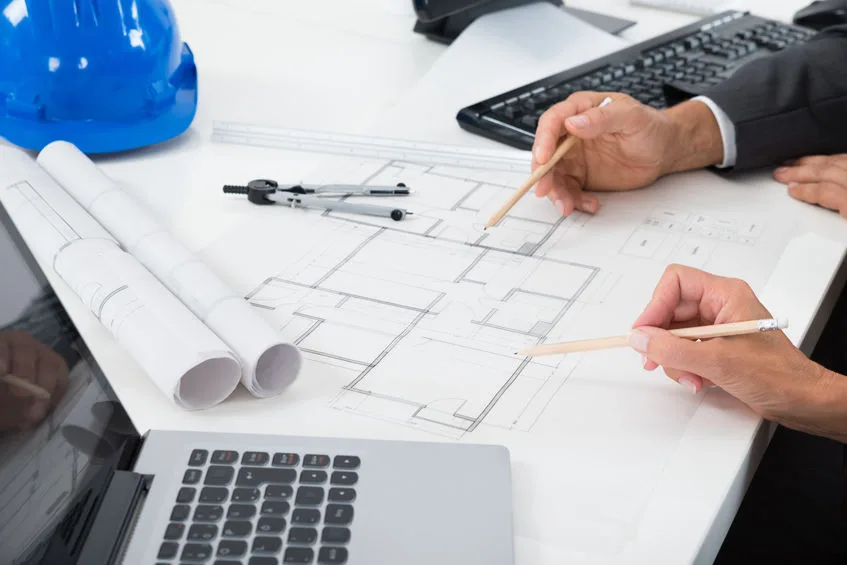Architect Guide to Sustainable Building Materials
Architect Guide to Sustainable Building Materials
Blog Article
Recognizing the Diverse Career Paths Available for Aspiring Architect
As an ambitious Architect, you have a globe of career paths waiting for you. Each course supplies one-of-a-kind obstacles and chances to apply your creative thinking and technological knowledge. Whether you're drawn to traditional design or the nuances of sustainable style, there's a particular niche that straightens with your interests. Recognizing these diverse options can shape your expert trip, yet which instructions will you select to discover first?
Standard Style: Creating Structures and buildings
Standard style concentrates on designing buildings and frameworks that blend performance with aesthetic allure. Your designs can show cultural heritage, showcasing local traditions while fulfilling contemporary requirements.
You'll create skills in drafting, model-making, and site analysis, enabling you to imagine and connect your concepts effectively. Involving with clients, you'll need to comprehend their vision and translate it right into viable layouts.
Moreover, constructing codes and sustainability techniques are essential in your job, guaranteeing your structures are risk-free and eco-friendly. As you grow in your occupation, you'll discover opportunities in household, commercial, or also remediation projects, each offering special difficulties. Welcoming standard design leads the way for a satisfying career that pays tribute to the past while shaping the future.
Urban Planning: Shaping Areas and Public Spaces
As an aspiring Architect, you can play a necessary duty as an urban organizer, changing exactly how areas connect and function. By using area engagement approaches, you'll ensure that residents have a voice fit their environment. Plus, incorporating sustainable style concepts will certainly aid develop rooms that not only meet today's needs yet also protect the future.
Function of Urban Planners
While lots of could think of architects as the sole enthusiasts behind structures, urban organizers play an essential duty in shaping the more comprehensive landscape of communities and public spaces. By teaming up with numerous stakeholders, you'll aid create parks, transport systems, and property areas that promote social communication and accessibility. Your knowledge in spatial design and community characteristics enables you to imagine future growth while preserving social heritage.
Neighborhood Interaction Strategies
Efficient area engagement methods are essential for urban coordinators to ensure that the voices of citizens are listened to and valued in the preparation procedure. To foster significant discussion, you need to focus on open forums and workshops where community members can express their ideas and worries. By proactively paying attention and including responses, you'll create spaces that reflect the community's needs, ultimately leading to more successful and sustainable city atmospheres.
Sustainable Design Principles
When making metropolitan areas, incorporating lasting style principles is vital for creating environments that thrive both environmentally and socially. Think about incorporating green rooms, like parks and gardens, to improve biodiversity and boost air quality.
Creating with water preservation in mind is additionally crucial-- assume concerning rain yards and permeable surfaces to manage stormwater. Involving area participants during the preparation procedure guarantees that the areas you create meet their needs and urge social communication. By accepting these principles, you'll add to vibrant, lasting urban landscapes that profit everybody.

Landscape Architecture: Developing Lasting Exterior Settings
As you explore landscape style, you'll uncover necessary design concepts that produce practical and lovely exterior spaces. Lasting techniques play an essential function in making certain these settings grow while minimizing ecological impact. Plus, you'll find a selection of career possibilities that permit you to make a real distinction in exactly how people engage with nature.
Layout Principles in Landscape
Comprehending layout concepts in landscape design is crucial for developing sustainable outside environments that integrate with nature. You'll need to contemplate aspects like range, equilibrium, and proportion to guarantee your layouts really feel natural and welcoming. Integrating indigenous plants not just enhances biodiversity yet likewise reduces water use, making your landscape resilient. Think about the circulation of space and exactly how people interact with it; pathways and seating areas need to invite expedition and leisure. Furthermore, pay interest to seasonal adjustments, designing with materials that complement the environments year-round (Architect). By focusing on sustainability and aesthetic appeals, you can produce exterior areas that enhance the community and promote health. Welcoming these principles will certainly establish a strong structure for your occupation in landscape architecture.
Lasting Practices Introduction
Lasting techniques in landscape style not just focus on aesthetics however likewise focus on ecological wellness and resource conservation. You can develop spaces that advertise dirt health and wellness, such as using natural products and exercising permaculture concepts. Eventually, these practices guarantee your layouts profit both individuals and the setting for years to come.
Job Opportunities Exploration
With a solid foundation in sustainable techniques, landscape style provides a selection of occupation paths that enable you to make a purposeful impact on the environment. You could function as a landscape developer, creating cosmetically pleasing and practical outside spaces, or concentrate on environmental remediation, helping to revitalize damaged ecological communities. Urban organizers commonly team up with landscape designers to develop green areas in metropolitan settings, enhancing city livability. If you're passionate concerning education, consider becoming a landscape style instructor, inspiring future generations. Furthermore, you could function with nonprofits focused on environmental sustainability or take part in research to innovate new practices. Each path not just shapes beautiful environments yet also promotes a healthier planet for future generations.
Sustainable Style: Concentrating On Eco-Friendly Practices
As you explore your profession in design, embracing green methods see it here can set you apart in an affordable field. Sustainable style concentrates on producing buildings that minimize ecological effect while enhancing resident wellness. By incorporating sustainable products, energy-efficient systems, and sustainable structure methods, you'll contribute to a greener future.
Begin by obtaining expertise of environment-friendly accreditations like LEED or BREEAM, which can strengthen your credentials. Think about how all-natural light, ventilation, and thermal effectiveness can enhance design. Work together with designers and ecological professionals to innovate solutions that decrease waste and save resources.
Don't neglect the value of neighborhood participation-- engaging regional stakeholders can influence designs that integrate with the setting. As clients significantly focus on sustainability, your proficiency in green practices will not only attract jobs however likewise satisfy your enthusiasm for accountable architecture. Accept this important aspect of the profession, and watch your occupation prosper.
Historic Conservation: Shielding and Bring Back Cultural Heritage
While you start on your building trip, think about the essential function of historic conservation in preserving our social heritage. This area concentrates on the defense and remediation of considerable structures, websites, and structures that inform the stories of our past. By taking part in historical conservation, you'll help protect the building tradition that shapes area identification.
As a historic preservation Architect, you'll evaluate historical value Visit Your URL and analyze the condition of structures. You'll work very closely with historians and preservationists to assure authentic repair strategies are used. This job path enables you to mix creative thinking with research study, allowing you to design remedies that value initial products and craftsmanship.
Your work not just adds to sustainability by reusing existing structures however also promotes a sense of satisfaction within areas. Accepting this path will certainly help you end up being a guardian of background, protecting the tales and aesthetic appeals that enrich our lives.
Interior Style: Enhancing Indoor Spaces
Historic preservation and interior architecture both share a dedication to improving the built setting, but they concentrate on different elements. While historical preservation emphasizes keeping a structure's cultural and historic value, interior style absolutely nos in on maximizing indoor areas for performance and aesthetics.
As an aspiring Architect, you'll locate that interior style permits you to blend creative thinking with technological skills. You'll make spaces that not just look great yet likewise advertise convenience and performance. This field includes comprehending exactly how light, shade, and materials communicate within a space, influencing mood and use.
You'll service various tasks, from domestic homes to industrial workplaces, making sure that each setting satisfies the needs of its occupants. By focusing on customer experience, you can transform interiors right into useful and inspiring rooms, making a substantial influence on how individuals interact with their surroundings. Embrace the possibility to enhance indoor settings and form the method people function and live.
Industrial Style: Combining Functionality With Looks
Commercial design plays a vital function in developing items that effortlessly blend aesthetics with functionality, making sure that what you make use of day-to-day is not just visually attractive but also practical. As an aspiring Architect, you could involve yourself in this field, concentrating on developing everything from furniture to consumer electronic devices. Your work includes understanding individual demands, products, and making processes, permitting you to develop ingenious remedies that improve daily experiences.
In industrial design, you'll commonly team up with designers, manufacturers, and marketing professionals, making sure that your designs are not just lovely but also practical. You'll learn to balance type and function, focusing on functionality without sacrificing style. By sharpening your abilities in sketching, 3D modeling, and prototyping, you'll be well-equipped to bring your concepts to life. This profession course supplies a dynamic environment where imagination fulfills practicality, making it a satisfying option for architects curious about shaping the items of tomorrow.
Regularly Asked Inquiries
What Educational Credentials Do I Need to End Up Being a Designer?
To come to be a designer, you'll require an expert degree in design, commonly a Discover More Bachelor's or Master's. Additionally, you'll need to complete an internship and pass the Architect Registration Exam to exercise legally.
Are There Qualification Demands for Various Architectural Occupation Paths?
Yes, there're accreditation needs for various architectural courses. Architect. You'll require to pass exams, complete internships, and occasionally seek specialized training, depending on your chosen focus, like landscape architecture, city style, or historical preservation
What Software Program Abilities Are Crucial for Engineers Today?

Just How Can I Gain Practical Experience While Studying Design?
You can obtain practical experience by interning at architectural firms, joining design competitors, offering for area tasks, or teaming up with schoolmates on real-world tasks. These chances boost your abilities and develop useful connections in the sector.
What Job Opportunities Exist Outdoors Standard Style Firms?
You can check out various task chances outside conventional design companies, like city planning, interior layout, landscape style, building and construction management, property growth, and even roles in sustainability consulting. Each deals special challenges and rewards.
Whether you're attracted to typical style or the nuances of sustainable style, there's a specific niche that lines up with your passions.When making metropolitan spaces, including lasting style principles is vital for developing environments that grow both environmentally and socially.As you check out landscape style, you'll discover crucial style concepts that create stunning and practical outside spaces.Recognizing layout principles in landscape architecture is necessary for developing lasting exterior environments that balance with nature.In commercial style, you'll typically collaborate with marketing professionals, makers, and engineers, ensuring that your layouts are not just beautiful yet also feasible.
Report this page